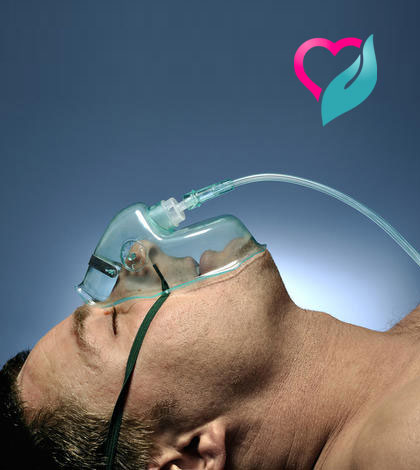Hypoxia can be life threatening – for cells and the organism. Hypoxia literally means “low oxygen,” but is defined as a deficiency in the amount of oxygen that reaches the tissues of the body.
[wp_ad_camp_1]
It differs from hypoxemia, which means an inadequate amount of oxygen traveling in the blood. Hypoxia may be due to hypoxemia, for example, inadequate amount of oxygen reaches the tissues because there is an inadequate amount of oxygen in the blood.
The lack of oxygen in tissues is also known as “oxygen starvation.” If a complete lack of oxygen occurs in the tissues, it is termed anoxia.
Hypoxia may affect the whole body (generalized hypoxia), or a specific organ or area of the body (tissue hypoxia). It can also be classified as acute or chronic, with acute meaning a rapid onset, and chronic meaning that hypoxia has been ongoing for some time.
[wp_ad_camp_4]
Types of Hypoxia
The different types of hypoxia are:
- Hypoxic hypoxia (hypoxemic hypoxia) – In this type of hypoxia, the tissues do not have enough oxygen because there is a lack of oxygen in the blood flowing to the tissues.
- Anemic hypoxia – In the setting of anemia, low hemoglobin levels result in a reduced ability of the blood to carry oxygen that is breathed in, and hence, a diminished supply of oxygen available to the tissues.
- Stagnant hypoxia (circulatory hypoxia) – This form of hypoxia is caused by inadequate blood flow, which results in less oxygen available to the tissues.
- Histiotoxic hypoxia – With histiotoxic hypoxia, an adequate amount of oxygen is inhaled through the lungs and delivered to the tissues, but the tissues are unable to use the oxygen that is present.
- Metabolic hypoxia – Metabolic hypoxia occurs when there is more demand for oxygen by the tissues than usual. Oxygen may be absorbed, transported, and used properly by the tissues, but due to a condition that raises metabolism, it is still not enough. An example of this is sepsis (a serious and overwhelming infection.)
[wp_ad_camp_2]
Symptoms and Signs
The symptoms of hypoxia can vary between different people, and by how long the symptoms have been present. Some of them include:
- Dizziness or fainting (syncope)
- Shortness of breath (dyspnea)
- Confusion, lethargy, and/or lack of judgment
- Headache
- Rapid heart rate (tachycardia)
- Elevated respiratory rate (tachypnea)
- Euphoria and a sense of well-being
- Tingling, warm sensations
- Elevated blood pressure (hypertension)
- Lack of coordination
- Visual changes, such as tunnel vision
- Elevated red blood cell count (polycythemia) in people with chronic hypoxia
- A bluish tinge to the lips and extremities (cyanosis
Effects of Hypoxia
The organs most affected by hypoxia are the brain, the heart, and the liver. If the hypoxia is severe, irreversible damage can begin within 4 minutes of the onset. Coma, seizures, and death may occur in severe cases. Chronic, milder hypoxia can also cause damage to the major organs of the body.
Causes of Hypoxia
It is not surprising that lung diseases are a significant cause of hypoxia, but there are many other causes as well. Some causes of the specific types of hypoxia include:
- Altitude sickness – The FAA recommends supplemental oxygen for flights over 10,000 feet and over 6,000 feet at night (because a pilot’s vision is very sensitive to low oxygen).
- Lung conditions – Inadequate air exchange in the lungs due to illnesses such as COPD, asthma, lung cancer, pneumonia, rheumatoid lung disease, and pulmonary hypertension.
- Hypoventilation – Hypoventilation simply means “not breathing enough.” This can be critical if the brain does not tell the lungs to breathe, such as when under anesthesia, due to a stroke or head injury, as a side effect of medications for pain, or as a reaction to illegal drugs. It can also be “peripheral” due to an airway obstruction that interferes with breathing, such as choking (when a foreign body lodges in the trachea or large airways of the lungs), drowning, suffocation, or in a cardiac arrest when breathing stops.
- Anemia of any cause – This can include iron deficiency anemia, pernicious anemia, and chemotherapy-induced anemia.
- Methemoglobinemia – Methemoglobinemia, also known as affinity hypoxia, is an abnormal hemoglobin that doesn’t bind oxygen very well.
- Carbon monoxide poisoning – With carbon monoxide poisoning, hemoglobin is unable to bind oxygen.
- Edema – Edema, a swelling in the tissues (like from heart failure), can limit the ability of oxygen present in the blood to adequately reach the tissues.
- Ischemic hypoxia – Obstruction to the flow of blood carrying oxygen, like from a clot in a coronary artery (a heart attack), can prevent the tissues from receiving oxygen.
Treatment
The treatment of hypoxia will depend upon the underlying cause. While you and your doctor are working together to determine the cause, she may recommend oxygen therapy if you are short of breath or having other symptoms suggestive of moderate or severe hypoxia. If your symptoms are severe, mechanical ventilation with a ventilator may be needed.
However one also needs to address lifestyle risk factors like sleep positions, mouth breathing, overeating, insufficient or incorrect physical exercise, nutritional deficiencies, and many others, in order to achieve changes in breathing patterns and sufficient oxygen in our cells.
[wp_ad_camp_3]
Image courtesy: healthtap.com ,





















